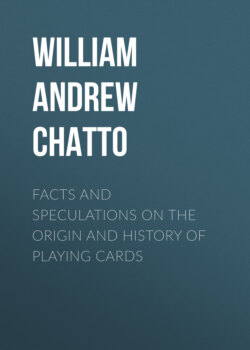Читать книгу Facts and Speculations on the Origin and History of Playing Cards - William Andrew Chatto - Страница 6
ОглавлениеNo. 1.
No. 2.
No. 3.
No. 4.
No. 5.
No. 6.
In the annexed specimens of Chinese cards, Nos. 1 and 2 are the first and third of the suit of nine myriads of Kwan; Nos. 3 and 4 are the one and the three of the suit of cakes; No. 5 is the one of the suit of chains; and No. 6 is that of the three superior cards, which is called the white flower.
Besides those above described, the Chinese have several other varieties of cards: one pack or set is called Pih-tsze-pae, the hundred boys' cards; another, Tseen-wan-jin-pae—"a thousand times ten-thousand mens' names cards," containing the names of persons famous in Chinese history; and a third has the same name as Chinese Chess, Keu-ma-paou, chariots, horses, and guns. This latter name corroborates what has been previously said about the probability of the game of cards having been suggested by that of chess.
The marks to be found on Chinese cards scarcely afford a gleam of light by which we might judge of their relation to the cards of other countries: in a pack of such as are chiefly used in Cochin China, I have observed the form of the diamond nearly the same as it appears on English cards; and in a pack of the Chinese cards called Tseen-wan-che-pae, the mark of the suit of Nine Cakes is nearly the same as that of the old Italian Danari, which Galeottus Martius—in his treatise 'De Doctrina promiscua,' written about 1488—considers to have been meant for a loaf.
The cards commonly used in China, are much narrower than ours; an idea of their size may be formed from the specimens given, making allowance for a small margin of white paper all round, but rather wider at the top and bottom than at the sides. The Chinese name for a card, considered singly, or as one of the pieces of a pack or set, appears to be Shen, a fan.
